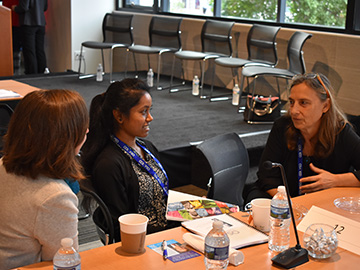
OSA Fellow Jannick Rolland talks with several participants at the Global Women of Light symposium.
On the first day of the Frontiers in Optics/Laser Science 2017 conference, dozens of industry leaders, researchers, students and other optics professionals came together at OSA’s headquarters in Washington, D.C., in the second “Global Women of Light” symposium. The all-day event, co-sponsored by the OSA Foundation and Women in Science, Technology, Engineering and Entrepreneurship (WiSTEE Connect), focused on the best ways to boost the presence of women in leadership positions in science and engineering.
As the event’s morning session unfolded, a number of the participants with long experience in working toward more gender equity suggested that the answers will lie partly in the actions of individual women, pursuing their careers with an entrepreneurial drive and actively seeking the sometimes hidden information and resources that underpin career success. But they further stressed that solutions also need to come from cultural changes led from the top.
The mid-career trap
Kicking off the event was Jie Qiao, an associate professor at the Rochester Institute of Technology, N.Y., USA, and the founder and president of the WiSTEE Connect. Qiao stressed from the outset that, while there’s an important and needed dimension of encouraging students and young researchers to focus on science, the data suggest that a far larger problem for women in the scientific workplace lies in mid-career, as researchers transition to leadership roles in their organization.
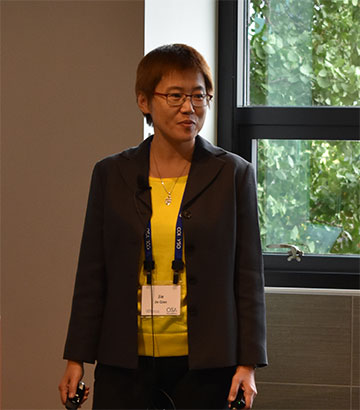
Jie Qiao, the founder and president of WiSTEE Connect, stressed the need for women to be “entrepreneurs in their own careers.”
Qiao noted, for example, that in academia, women occupy around 23 percent of assistant professor positions in science and engineering, but only 9 percent of the full professor positions. And for engineering in particular, the data further suggest that, around five years into their careers, women begin abandoning the field, at a rate of around 5 percent per year. “This is not a pipeline issue,” Qiao said, stressing that the representation of female students at the undergrad, master’s and doctoral issue are all increasing. “The drop-off is happening after we enter the field, in mid-career.”
Being “the CEO of your career”
Qiao observed that she started WiSTEE Connect to help address that leaky mid-career pipeline, and to advance the goal of getting women into leadership positions in science through mentorship, networking, and information sharing. Doing so, she suggested, is vital for women’s position in scientific institutions overall. “People are tribal,” Qiao said, “and all of the institutional structures [in science and engineering] are made by men. How do you change the structure without having women in leadership positions?”
One path toward greater representation of women in science, she suggested, will come from women themselves—whom she encouraged to look at themselves as “entrepreneurs” in their own careers. Infusing their own career planning with an entrepreneurial spirit and skillset—whether at an academic institution, a big company or a start-up—can, she argued, be an empowering organizing concept.
“I’m not asking each of you to form a company,” she said. But “entrepreneurship is a way of thinking, and of creating value. The perspective can greatly empower a woman’s career.” Later in the morning, one of the guest panelists, Susan O’Keefe, vice president at Edmund Optics, sounded this note in a different way. “You are the CEO of your career,” she told audience members. “If you don’t have a plan, then you don’t have a complaint.”
Defining moments
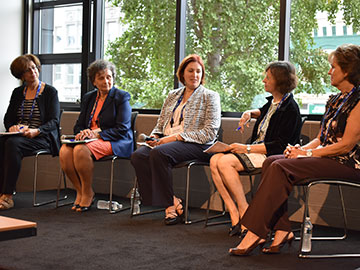
Panelists in the morning discussion included (left to right) Ursula Keller, ETH Zurich; Frederica Darema, U.S. Air Force Office of Scientific Research; Aleksandra Boskovic, Corning Inc.; Dominique Dagenais, U.S. National Science Foundation; Susan O’Keefe, Edmund Optics.
After Qiao’s remarks, the morning session swung into a panel discussion, in which five leading women scientists and engineers from academia, government and industry shared some of the lessons learned, and their thoughts about the missing links in building women’s presence in leadership positions. Qiao started things off by asking the panelists what they would consider a “defining moment” in their careers. And the answers were sometimes surprising.
Aleksandra Boskovic, research director for optics and thin films at Corning International, for example, noted that, while “every day is a defining moment,” she said that perhaps the two biggest defining moments for her in her career were the two times she became pregnant. Each pregnancy, she noted, forced her to “prepare immensely for the time I’d be out of the office.” That preparation, she maintained, actually defined her career because, both times, it led to a significant promotion.
“When I look back,” Boskovic reflected, “the reason I got offered these jobs—which were dream jobs for me—is because I actually took time to think about my career, think about what I wanted to do next,” and put in place a structure that allowed her to think about doing something different. “It’s kind of counterintuitive,” she said. “You’d think having children would hold me back, but it actually didn’t. It helped me.”
“You have to allow yourself to dream,” Boskovic concluded. “You have to think about how you’re going to make it work—not how you’re going to fail at it.”
Rules of the game
The discussion then moved to tactics for overcoming the hidden barriers for women’s advancement in organizations. All of the panelists agreed that the barriers were real and troubling. And they tended to find part of the answer to overcoming them in getting good information.
“If you want to be successful, you need resources,” said OSA Fellow Ursula Keller, of ETH Zurich, Switzerland. “And women and minorities tend to be given fewer resources.” As a result, these underrepresented groups need to be proactive, leveraging their personal networks to find out the resources that men commonly receive in support of their own work—information that, Keller noted, she herself wasn’t actually given when she began her career as the only woman faculty member in her department.
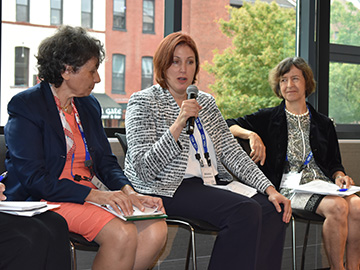
“There are rules for any game, including the work game” said Boskovic of Corning. “And they’re set up mainly by men.”
Boskovic agreed. “There are rules for any game, including the work game,” she said, “and they’re set up mainly by men.” That puts a premium, she continued, on actively seeking out what those rules are, and what is considered success in the organization. “You might bring a different element to the game,” she said, which might be quite positive. “But if you don’t understand what the rules are, you won’t win.”
Tapping the network
Dominque Dagenais, a program director at the U.S. National Science Foundation, added that in her experience, the key to garnering such information is cultivating and leveraging a strong network—one goal of the WiSTEE Connect symposium itself. And doing so can make a difference; Dagenais noted that in her career she had frequently encountered situations and barriers that seemed opaque, but once she “understood what was going on,” she could find ways to address the problems and move forward.
Keller agreed on the importance of networking events, such as the three-times-a-semester lunches for women faculty that she and colleagues have organized. It creates a structure “where we can help each other,” she said.
But several of the panelists also noted that where networking was particularly important was outside of the confines of the woman’s institution. “We do a lot of networking internally,” said Dagenais. “What I see is the absence of networking externally.” That networking, she suggested, is important for the community at large, as it’s the way funding bodies and professional organizations become aware, for example, of women who would be strong candidates for awards or other professional recognition.
Bucking the culture
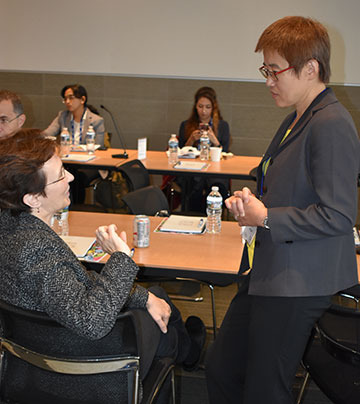
While they discussed at length how women can help themselves, and each other, in boosting their ranks within leadership positions, they also addressed the pervasive issues of male-dominated corporate cultures and widespread unconscious bias. And Keller in particular noted that cultural change “needs to come from the top,” rather than from the bottom up.
The panelists suggested several strategies for bucking these cultural dynamics. One, according to several panelists, was to focus on data, rather than anecdotes or individual examples of unfair treatment in the workplace. “Bring the facts,” advised O’Keefe, “and stay away from the emotions.”
They also emphasized the need for individual women to model support for other women in their organizations—and to speak out for themselves. Frederica Darema, the first female director of the U.S. Air Force Office of Scientific Research, noted, for example, the need to “make sure credit is given where it’s due,” by highlighting accomplishments of fellow women employees that might go unnoticed (or, even worse, be claimed by others). And Keller noted that individuals can take this kind of step at every stage in their careers—even as students.
O’Keefe also noted that women need to develop their own “professional brands,” and promote themselves—something, she suggested, that women often don’t do. “You have to find a way,” she said, “because men will do it.”
In the long run, several candidates said, the most important issue is fairness—and making sure that the proverbial playing field is indeed a level one. “The only men that have to fear intelligent women,” said Keller, “are the mediocre men.”
